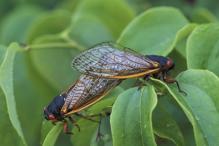
From the Peabody Museum, via The Mercurial
An extraordinary natural phenomenon is about to take place. This year the 17-year cicada will emerge from colonies in undisturbed forested regions in south-central Connecticut. Expect to see and hear these fascinating creatures starting at the end of May and throughout the month of June.
The species of periodical cicada that will emerge in our area this year (Magicicada septendecim L.) spends 17 years developing underground as a nymph, feeding on sap from tree roots. For a short time in early summer of the 17th year, the nymphs of the entire brood emerge around sunset, climb up tree trunks and transform into beautiful winged adults that have black bodies with red and yellow trim, ruby-like eyes and stiff glossy wings. Within a week males begin to sing a high-pitched song to attract females. After mating, the females then carve tiny slits in small tree branches and lay their eggs. Though sometimes small branches may wilt, the cicadas rarely cause any significant damage to entire trees. The adult 17-year cicada lives for no more than a few weeks. After mating and egg-laying, they quickly die. When the eggs hatch later that same summer, the tiny nymphs climb down and burrow into the ground to begin their long underground development.
The Return of the 17-year Cicadas! exhibition will feature a timeline detailing Yale’s historical involvement in 17-year cicada emergences dating back to 1843. On display will be video of the cicada emergence and live cicadas in a terrarium, with information on their biology and life cycle, as well as range maps. Find out the differences between annual cicadas (the “dog-day” cicadas you see and hear in backyards every year) and periodical cicadas, and learn about the environmental effects of humans on cicadas and vice versa.
For people who live or work in the habitat of the 17-year cicada, its emergence sometimes causes concern. These species emerge in vast numbers because their only defense against predators is “predator satiation” —their sheer numbers overwhelm the appetites of predators. But 17-year cicadas are completely safe. They do not kill trees or other plants, and do not sting, bite or harm humans or other animals. They are even safe for pets (and us!) to eat. To preserve their unique way of life, the Yale Peabody Museum strongly discourages the use of pesticides or other measures that can be harmful to these remarkable creatures.
The Peabody Museum is located at 170 Whitney Ave. in New Haven, CT. For more information, visit the museum’s website or call (203)432-5050.
